IJN Kaga (1927)
 Japan, 1927. Fleet Aircraft Carrier
Japan, 1927. Fleet Aircraft Carrier
WW2 IJN Aircraft Carriers:
Hōshō | Akagi | Kaga | Ryūjō | Sōryū | Hiryū | Shōkaku class | Zuihō class | Ryūhō | Hiyo class | Chitose class | Mizuho class* | Taihō | Shinano | Unryū class | Taiyo class | Kaiyo | Shinyo | Ibuki |The Kaga, second IJN fleet aircraft carrier
IJN Kaga was the third IJN carrier to enter service, converted, as her sister ship Akagi, on a cancelled capital ship of the original 8-8 plan, according to the Washington treaty. But contrary to the former, Kaga was not the first admiralty choice for a conversion. She was based on a battleship. Battlecruisers were the obvious choice, made already by the Royal Navy and US Navy. The IJN planned for a coherent class of two similarly converted vessels, Akagi and Amagi. But the latter was so badly damaged during the Great Kanto earthquake in 1923 that there was no other choice than going back to the only mpst advanced capital ship in construction at that time. And it was Kaga, of the Tosa class.
She would later constitute with Akagi, the Zuikaku class, Hiryu and soryu the famous First air fleet, or “Kido Butai”, the elite unit of carriers of the Imperial Japanese Navy, and best of its kind in December 1941. Kaga underwent the first conversion as Akagi, but adapted to her different hull, resulting in a longer process. As Akagi, she was entirely rebuilt in the next decade, following the progress of aviation, but was even completed sooner. She became a veteran of the Chinese Campaign, and made a team with IJN Akagi into the newly created 1st Carrier Division of the Kido Butai. She thus participated in the Pearl harbour attack, the raid on Darwin and Java, the Indian Ocean raid, missed the Coral Sea but was in action at Midway, under overall command of Chuichi Nagumo.
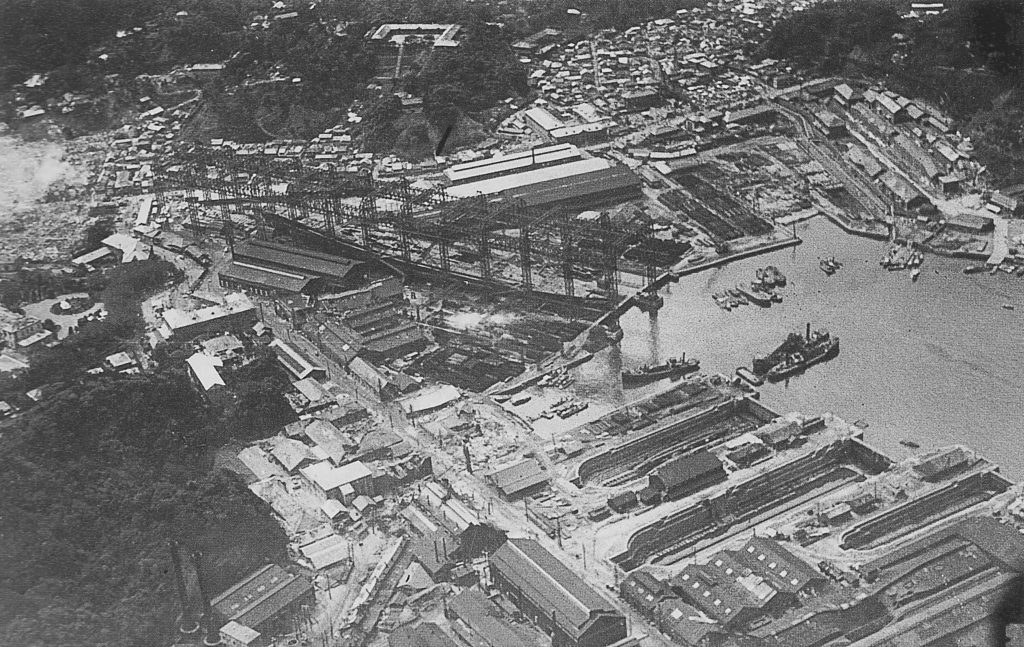
The Yokosuka Shipyard after the great Kanto earthquake, showing the IJN Amagi badly damaged
From Battleship to Carrier
IJN Kaga was originally planned in 1918 as a Tosa-class battleship. Her name, 加賀, came from the former Kaga Province (now Ishikawa Prefecture).
These four 26-knots next generation fast battleships displaced 44,200 t (43,500 long tons), armed with an extra 41 cm (16.1 in) gun turret compared to the previous Nagato. Tosa was laid down at Mitsubishi Shipyard in Nagasaki on 16 February 1920, and Kaga at Kawasaki Shipyard, Kobe on 19 July. But the latter was faster to be launched, on 17 November 1921 (December for her sister ship). While she was on completing stage, the treaty of Washington was signed, and construction suspended. On 5 February 1922, following the treaty, both were canceled. Later they were scheduled to be scrapped according to Chapter I, Article IX, but the admiralty realized it could be kept instead for one of the authorizations of the treaty: Convertion into aircraft carriers, up to 33,000 long tons standard.
What decided for her was Great Kantō earthquake (1923) which damaged Amagi’s hull so bad her conversion was no longer and option. Only Akagi remains, and to seek for a pair, Kaga was selected instead. This was formalized on 13 December 1923. Work did not started yet. Indeed, plans had been drawn, based on the Amagi class, and needed to be reworked entirely. This process took until 1925, so two years, giving an idea of the task. Meanwhile, the earthquake damage at Yokosuka needed to be repaired.
Design of the Kaga

The engineer’s task for the conversion was not that simple. The Amagi class has been chosen because of their longer hull, lesser beam, and reduced armor, better suited to be converted as fleet carriers, like the Lexingtons were. The Japanese admiralty was fully aware of the latter. It was not the case for the Kaga. History showed later how badly suited battleships were for fleet carriers, like HMS Eagle (former dreadnought Almirante Cochrane) or the French Béarn, former Normandie class dreadnought. Both were too slow for fleet service with a small hangar.
Nevertheless, if the general design philosophy of both the Kaga and Amagi class were about the same, and the Kaga fortunately had the same beam, but 20 m shorter. Machinery allowed for 91,000 shp (68,000 kW) versus 131,000 on the Amagi so she was noticeably slower. Also, to reduce her overall displacement, it was evident that armour needed to be cut back. For the rest, the same considerations about the armament left or removed were made, in a debate between the naval architecture bureau and the admiralty. The latter wanted to keep at least the integrality of the secondary battery, some even proposing to keep the two main forward turrets A and B, possibly with the take-off platform mounted on a pivot resting on B turret.
In her final version, with her armour mostly removed or thinned out, she displaced 26,900 long tons (27,300 t) standard, 33,693 long tons (34,234 t) fully load, nearly 6,000 long tons (6,100 t) less than her designed displacement as a battleship and fitting with a margin in the Washington treaty carrier tonnage limit.
This even left room for additional improvements. However she was also designed at a time naval aviation was still largely experimental, and on this large hull, Japanese engineers opted for a division of tasks, between the low and middle take off platforms, directly facing the hangars, and the top main flight deck, used to recover aircraft. This looks at a sound idea at the time, allowing faster operations on paper. But it was also in line with the small and light biplanes of the time, which needed just small surfaces to take off. With the development of all-metal monoplanes in the early 1930s, twice as heavy, the middle deck in particular was no longer able to be used as a flight deck, and at the lower deck the crew needed to block the wheels while the pilot setup full throttle, in place of a proper catapult, just barely made it clear of the deck. Reconstruction became an imperative (see later).
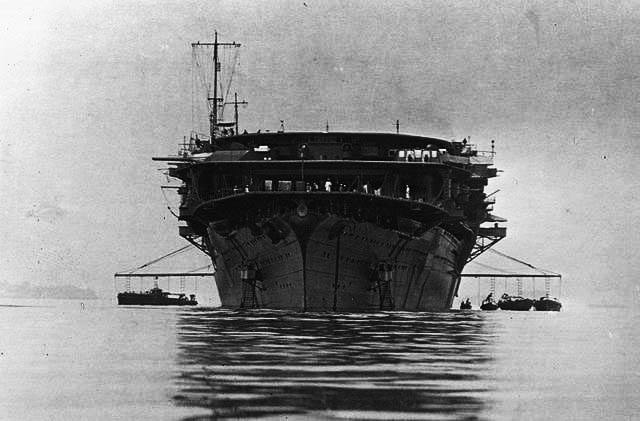
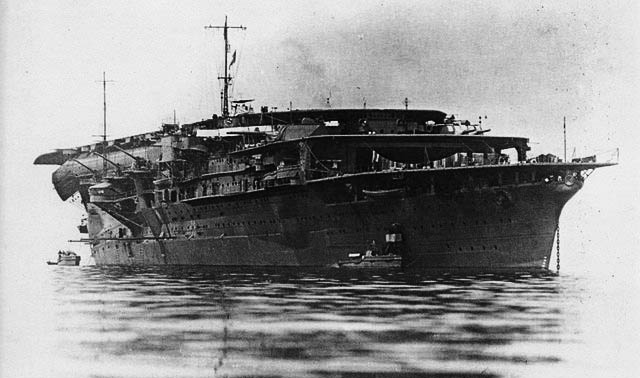
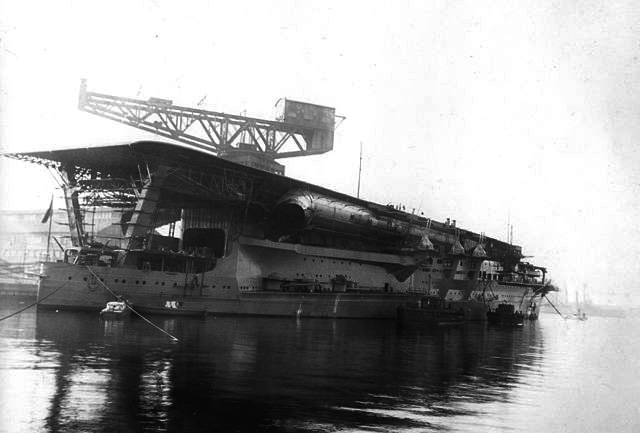
Kaga fitting out in Ikari, 1930
Hangar and landing decks
Much like the Akagi, Kaga was fitted with two flying-off decks, typically “stepped down”, created separated flight decks extending for just two-thirds of the hull. In theory, this allowed multiple take off from the hangars while planes landed on the main flight deck, a faster cycle. But since aircraft quicky grew in size and weight, this became not practical. Longer distances required more space, and only the main flight deck could procure it, provided it had an extension. IJN Kaga was reconstructed in 1935 like the Akagi, eliminating its lowest hangar, flight decks, and extending the main hangar and its flight deck above.
As completed, Kaga still displayed two main hangar decks and and an auxiliary hangar at the lowest level for eight dismounted spare aircraft, extending her overall capacity to 60 aircraft. This was six less than Akagi.
-Her main flight deck measured 171.2 meters (561 ft 8 in) by 30.5 meters (100 ft) wide.
-Her middle flight was just 15 meters (49 ft 3 in) long, in front of the bridge (planes to take off were moved around). It was reserved to fighters, like the nimble 1MF. The corresponding hangar was mostly out in the open, but with not too much seawater interference at this height.
-The lower flight deck was longer and better fitted for TBs at 55 meters (180 ft 5 in) long. There was no incumberance in front of the enclosed hangar, and the front opening could be closed in case of heavy weather to avoid seaspray.
Her arresting gear was a French transverse system proposed by the French on their aicraft carrier Béarn, known in Japanese service as the “Model Fju” (Fju shiki). Not very satisfactory it was replaced during reconstruction.
The deck was covered with landing paint marks specific to Japanese practice.

Kaga’s initial sections as designed
Armament
-Main armament: Ten 20 cm/50 3rd Year Type guns, two in twin-gun turrets forward, either side of the middle flight deck, and six in casemates aft. Basically these were the same as in Akagi, a heavy cruiser armament. It was argued in 1922 necessary in case she was surprised by enemy cruisers, present in the early Carrier doctrine of that time. When it became clear this was impractical her reconstruction saw the twin turrets eliminated and the casemate one kept.
-Secondary armament: It was not the same as Akagi, comprising the six (three twin per side) new 12 cm dual purpose guns (4.7 in) in side sponsons.
These 10th Year Type Model A2 guns like Akagi, could not fire across the flight deck. They fired 20.3 kg shells at 825–830 m/s (2,707–2,723 ft/s), and max elevation of 45°, 16,000 meters range or 10,000 m ceiling at 75° elevation. Rate of fire was 6-8 rpm.
For gunnery control, Kaga was fitted with two Type 89 directors for the main guns and two Type 91 Kōshaki (manually powered) AA directors for her dual purpose battery.
Light AA was added after reconstruction in the 1930s.

Design scheme, IJN Kaga’s reconstruction, showing the profile of the hangar and initial truncated funnels, overall view of the hangar and placement of the planes
Air group
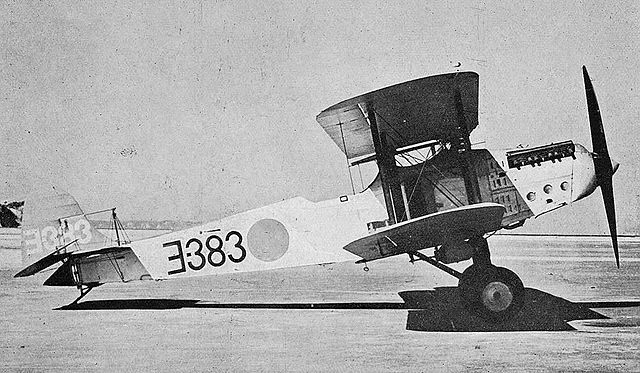
Mistubishi B1M
As completed, IJN Kaga carried an air group 52 planes plus 8 spares, so 60 in all.
-28 Mitsubishi B1M3 torpedo bombers
-16 Nakajima A1N fighters
-16 Mitsubishi 2MR reconnaissance aircraft.
Fo more info about these models, check out the new IJN naval aviation section (work in progress)
Armour Protection
Kaga’s waterline armored belt was initially of 280 mm, and it was decreased to 152 mm (11.0 to 6.0 in). Also the upper part of her torpedo bulge received 127 mm (5 in) of armor and her deck armor was also reduced, from 102 to 38 mm (4.0 to 1.5 in). This was despite opposition from the “battleship faction” in the IJN, which maintained the ship needed to keep a powerful armament and relevant protection to deal with surprise attacks from US cruiser. While the heavy armament could maintain a distance with cruisers, armour was barely adequate to defeat 8-inches rounds. The belt was immune against 6-in rounds of light cruisers at any range, and but the sloped connection with the belt was impossible due to hangar design constraints. Critically, nothing is known about the protection of vital aviation gasoline tanks. There was no known bulkheads or armour stray above or around them. Like Akagi, the Shokaku pair, and other fleet aircraft of the kido Butai, (or light aircraft carriers for that matter), she was not considered “armoured”. Only IJN Taiho, launched on 7 April 1943, was as well of course as IJN Shinano, or the Unryu class in a lesser extent (at least compared to the Zuikaku class they replaced).

IJN Kaga in 1930
Powerplant
Th original powerplant was kept, consisting of four Kawasaki Brown-Curtis geared steam turbines (rated for 91,000 shaft horsepower (68,000 kW) total), passed onto four drive shafts, and four propellers. Her battleship to speed was planned to be around 26.5 knots (49.1 km/h; 30.5 mph), but the reduction in displacement down to 33,693 long tons allowed a rise to 27.5 knots (50.9 km/h; 31.6 mph). This was the speed she achieved in her sea trials on 15 September 1928.
The turbines were fed by high pressure steam coming from twelve Kampon Type B (Ro) boilers, with a working pressure of 20 kg/cm2 (2,000 kPa; 280 psi). This was a mixed-firing lot, with eight oil-fired and four coal-burning, but with oil injection to increase the burn rate. During reconstruction, she went to oil-only boilers like for Akagi, new models also, which boosted top speed, allowing to compensate for the added weight.
Autonomy: She carried 8,000 long tons (8,128 t) of fuel oil, 1,700 long tons (1,727 t) of coal. This have an initial range of 8,000 nautical miles (15,000 km; 9,200 mi), at 14 knots cruise speed. Due to swapping on oil boilers only, more economical, this range was also improved.
Another point related to her powerplant, crucial for aviation operation at the time, was exhaust gas dispensal. The swiveling funnels of Hōshō were laregmy seen as a failure, and so far wind-tunnel testing never provided the ideal solution. Akagi and Kaga both would test different solutions as a result. Kaga’s exhaust system was to evaluate its own recipe in real-world conditions. Her funnel gases were collected in a pair of long horizontal ducts. They were discharged at the rear of each side of the flight deck. However prominent naval architects feared that these would not prevent these hot gases to reach the flight deck. Theses proved accurate predictions during trials. Kaga in addition was slower than Akagi, and gases tended to interfere more with landing operations. Their heat also made nearby crew’s quarters almost uninhabitable. So averall, that point alone urged reconstruction, which was done just five years after completion, in 1933.

Author’s illustration of IJN Kaga in 1928
Kaga’s Specifications in 1928
Displacement: 26,900 t stabdard, 34,234 t fully loaded
Dimensions: 238.5 (782 ft 6 in) oa x 31.67 (103 ft 11 in) x 7.92 m (26 ft)
Machines: 4 Kawasaki Brown-Curtis, 12 Kampon B SWT mixed fired boilers
Maximum speed 91,000 shaft horsepower (68,000 kW) for 27,5 knots (50.9 km/h; 31.6 mph)
Range: 8,000 nautical miles (15,000 km; 9,200 mi) 14 knots
Armament: 10 × 200 mm, 8×2 127 mm DP
Aviation: 90 planes (72 active, 18 spare 1936)
Armour: Belt 152 mm (6 in), deck: 38 mm (1.5 in)
Crew: circa 1340

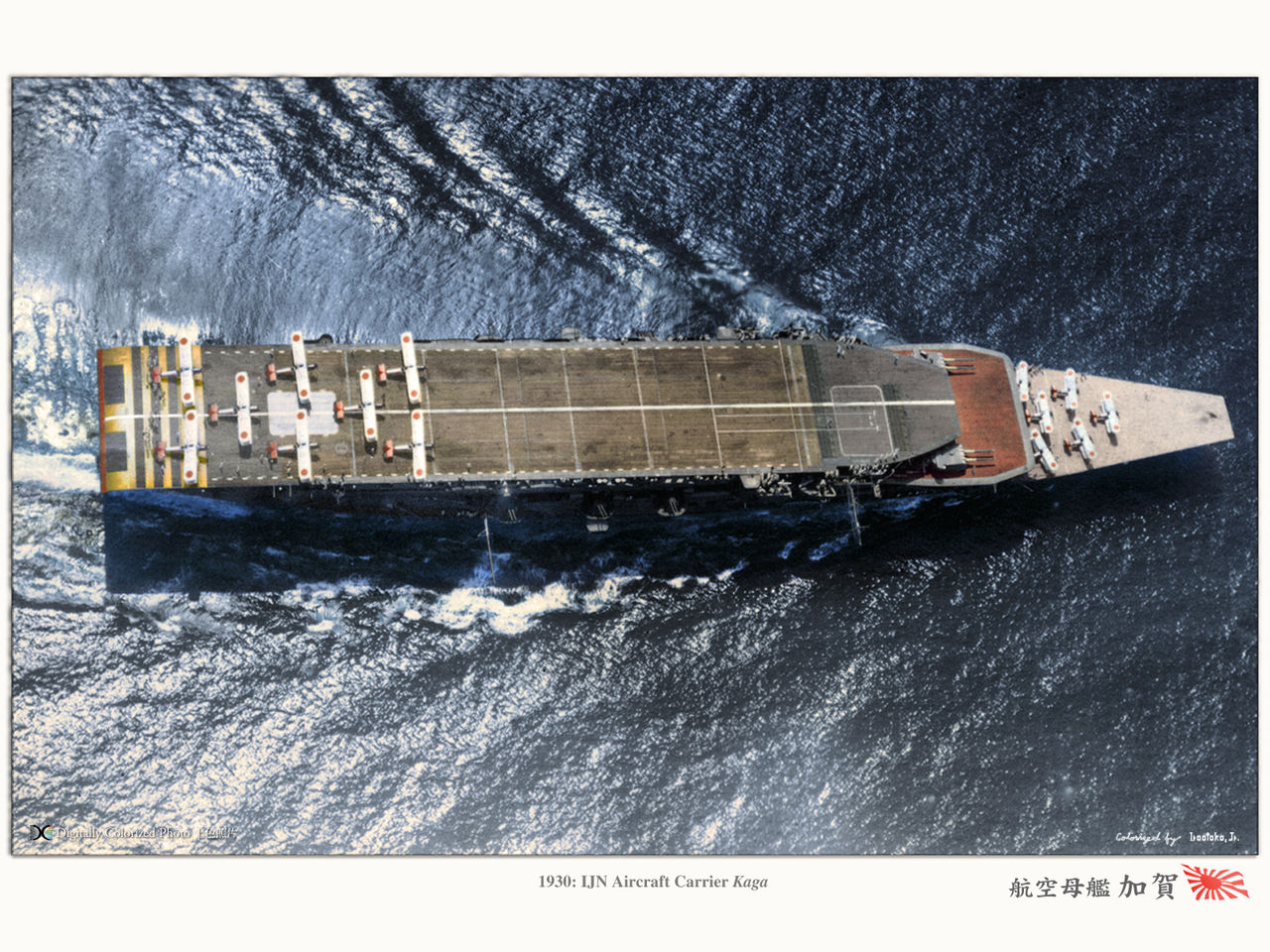
IJN Kaga in 1928, colorized by Irootoko Jr.
Second Reconstruction
In 1933–35 Kaga was sent to be rebuilt entirely and used as a prototype for Akagi’s reconstruction, which started right after her, delayed due to budget cuts. Every department was affected, but in particular planes management. She displaced 38,200 long tons standard (38,800 Lt) after reconstruction, but was faster, had a better range and carry more planes, although they were larger and heavier. This really was a tour de force.
Machinery:
Japanese engineers, knowing additions would be made in weight, started to overhaul the machinery. The shafts were in good state and so were not modified, but the propellers were already worn out and replaced by more modern models with improved performances. So they focused on improving her exhaust systems. Her new power plant included eight brand new oil-burning only Kampon Type B (Ro) boilers. They had a working pressure of 22 kg/cm2 (2,157 kPa; 313 psi) at 300 °C (572 °F). The multi-stage geared turbines were also replaced to take advantage of the power increase, which jumped from 91,000 to 127,400 shp (67,859 to 95,002 kW). As shown during trials this allowed now a top speed of 28.3 knots (52.4 km/h; 32.6 mph). The reworked interior and oil only storage also allowed an increased in range to 10,000 nautical miles (19,000 km; 12,000 mi) at 15 knots instead of 8,000.
Her lengthy funnel ducting was replaced by a single downturned starboard funnel. It was directly copied on the Akagi, and had a with a water-cooling system for the exhaust gasses. It also had a raising cover in case of severe list. This removal freed space, so that the these spaced were divided into two decks, converted into living quarters for the expanded air group.
Hangar and flight deck:
First, her two lower flight decks were eliminated and the space available enclosed and integrated into the hangars, extended to the bow, topped the extended flight deck above. This increased the her flight deck length to 248.55 meters (815 ft 5 in). The reclaimed hangar space, as well as better space management in beam and height raised her total aircraft capacity to 90 (72 operational planes, 18 in storage in spare parts in the former lower third hangar). In addition a third elevator was built forward, 11.5 by 12 meters (37 ft 9 in × 39 ft 4 in). Alos the two Bomb and torpedo elevators were modified so o allow their payload to be distributed directly to the flight deck. The arrester gear was now a Japanese-designed Type 1 system. Another impiorant change for her appearance was the construction of a small starboard island superstructure, with the bridge, admiral bridge and air operation bridge. But it was cramped and carried a small fire control system.

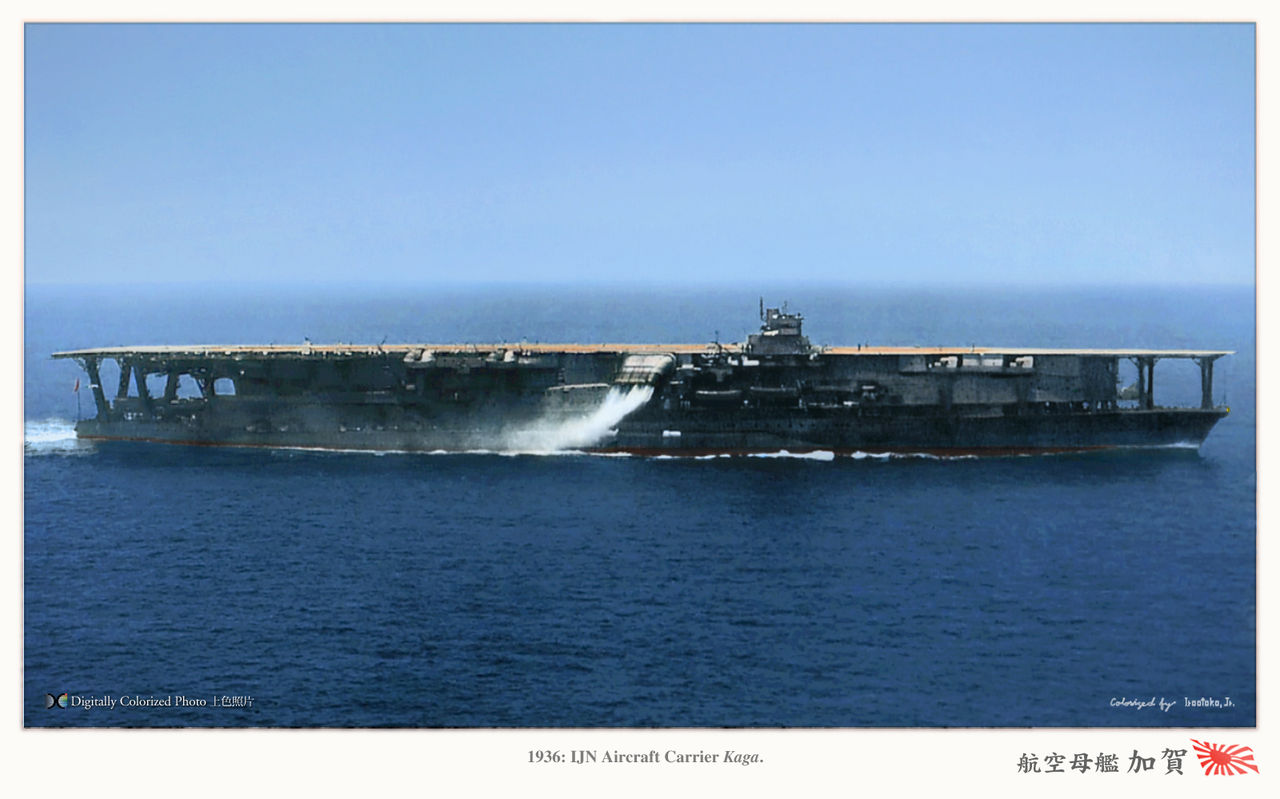
IJN Kaga in 1936, original and colorized by Irootoko Jr.
Hull
The hull was lengthened by 10.3 meters (33 ft 10 in) at the stern to reduce drag while a torpedo bulge was added above the side armor, and abreast the upper existing bulge as to increase further her beam and lower her center of gravity. The main hangar did not extended straight to the bow and stern but stopped about 20-30 m short, the flight deck being supported by five stories tall pillars. Since Kaga was taller than Akagi, this was even more striking. Both Kaga and Akagi were the tallest carriers in the IJN up to that point. Next carriers were purpose built and had a single hangar and much better stability.
Armament
-The ten 20 cm (7.9 in) guns, were retained while the two twin turrets were removed. In place, four new 20 cm 3rd Year Type No. 1 guns were placed in casemates close to her former casemate guns, all aft.
-Her twin 12 cm AA guns were replaced by eight new twin 12.7-centimeter (5.0 in) Type 89 guns, always placed in side sponsons, higher by one deck but still below the level of the flight deck. This allowed at least some measure of cross-deck fire vontrary to Akagi.
These guns fired 23.45-kilogram (51.7 lb) shells at 8-14 rpm to 700–725 m/s (2,300–2,380 ft/s), and a range of 14,800 m or ceiling of 9,400 m.
-Light AA was added as well, eleven twin 25 mm Type 96 gun mounts, in sponsons too at different heights. Most of them at the same level as the 127 mm guns.
These 110-120 rpm guns fired 0.25 kg (0.55 lb) shells at 900 m/s (3,000 ft/s) to 7,500 meters or 5,500 meters ceiling.
-Six 6.5 mm (0.26 in) Type 11 machine guns, but their position is uncertain, possible 2-4 were placed on the bridge.
The new AA as controlled by six Type 95 directors but for the dual purpose guns, the Type 91 anti-aircraft directors were kept, as the Type 89 for the main guns.
Protection issues
Despite this reconstruction, some issues remained:
-Kaga’s aviation fuel tanks directly incorporated into the structure, so prone leakage after a hit.
-Both the hangar and flight decks had little armor protection.
-The fully enclosed structure of the new hangar was not ventilated enough to evacuated fuel gases which could accumulate
-This was combined to the doctrine to refuel and reload planes in the hangar rather than on the flight deck.
-No redundancy in the fire-extinguishing systems and limited training for the damage control teams.
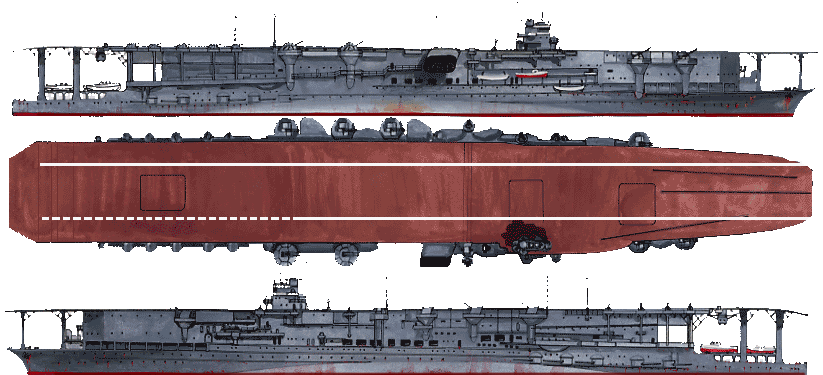
Author’s illustration of the Kaga in 1941
Kaga’s Specifications as rebuilt in 1937
Displacement: 38,200 long tons (38,813 t) (standard)
Dimensions: 247.65 m (812 ft 6 in), Beam: 32.5 m (106 ft 8 in), Draft: 9.48 m (31 ft 1 in)
Machines: 4 shaft Kampon geared steam turbines, 8 Kampon WT boilers
Maximum speed 127,400 shp (95,000 kW) for 28 knots (52 km/h; 32 mph)
Range: 10,000 nmi (19,000 km; 12,000 mi) at 15 knots (28 km/h; 17 mph)
Armament: 10 × 200 mm, 8×2 127 mm DP, 11×2 25 mm AA
Aviation: 90 planes (72 active, 18 spare 1936)
Armour: Belt 152 mm (6 in), deck: 38 mm (1.5 in)
Crew: circa 1700
Sources/ Read more
Sites:
http://www.combinedfleet.com/KAGA-Data-Page-Chen.htm
https://www.carrierbuilders.net/element/element.php?id=909
https://en.wikipedia.org/wiki/Japanese_aircraft_carrier_Kaga
http://www.combinedfleet.com/ships/kaga
http://navgunschl.sakura.ne.jp/koudou/ijn/buki/ammo/proj/3shiki.html
https://www.militaryfactory.com/ships/detail.asp?ship_id=ijn-kaga-aircraft-carrier
Hiraga Archives 1 2
https://muuseo.com/JAP_prpr/items/29
http://www.navweaps.com/Weapons/WNJAP_161-45_3ns.php
http://navgunschl.sakura.ne.jp/koudou/ijn/buki/gun/gun_data/40cm_45cal.html
http://navgunschl.sakura.ne.jp/koudou/ijn/buki/ammo/proj/3shiki.html
Brown, David (1977). Aircraft Carriers. New York: Arco Publishing Company.
Campbell, John (1985). Naval Weapons of World War Two. Annapolis, Maryland: Naval Institute Press
Cheung, Raymond; Davey, Chris (2015). Aces of the Republic of China Air Force. Aircraft of the Aces. 126. Oxford, UK: Osprey Publishing.
Cressman, Robert J.; Steve Ewing; Barrett Tillman; Mark Horan; Clark G. Reynolds; Stan Cohen (1990). A Glorious Page in our History: The Battle of Midway 4–6 June 1942. Missoula, Montana: Pictorial Histories Publishing Company, Inc.
Evans, David C. (Editor); Mitsuo Fuchida (1986). The Japanese Navy in World War II: In the Words of Former Japanese Naval Officers (2nd ed.). Annapolis, Maryland: Naval Institute Press.
Fuchida, Mitsuo; Masatake Okumiya (1955). Midway: The Battle That Doomed Japan, The Japanese Navy’s Story. Annapolis, Maryland: United States Naval Institute.
Gardiner, Robert; Gray, Randal, eds. (1985). Conway’s All the World’s Fighting Ships: 1906–1921. Annapolis, Maryland: Naval Institute Press.
Gill, G. Hermon (1957). Volume I – Royal Australian Navy, 1939–1942. Australia in the War of 1939–1945, Series 2: Navy (1st ed.). Canberra: Australian War Memorial.
Goldstein, Donald M.; Dillon, Katherine V., eds. (2004). The Pacific War Papers: Japanese Documents of World War II. Dulles, Virginia: Potomac Books.
Hata, Ikuhiko; Izawa, Yasuho (1989) [1975]. Japanese Naval Aces and Fighter Units in World War II. Translated by Don Cyril Gorham. Annapolis, Maryland: Naval Institute Press.
Howarth, Stephen (1983). The Fighting Ships of the Rising Sun: The Drama of the Imperial Japanese Navy 1895–1945. Fairfield, Pennsylvania: Fairfield Graphics.
Ireland, Bernard (2007). Aircraft Carriers of the World. London: Southwater.
Jentschura, Hansgeorg; Jung, Dieter; Mickel, Peter (1977). Warships of the Imperial Japanese Navy, 1869–1945. Annapolis, Maryland: United States Naval Institute.X.
Lengerer, Hans (1982). “Akagi & Kaga”. In Roberts, John (ed.). Warship VI. London: Conway Maritime Press.
Lundstrom, John B. (2005). The First Team: Pacific Naval Air Combat from Pearl Harbor to Midway (New ed.). Annapolis, Maryland: Naval Institute Press.
Parshall, Jonathan; Tully, Anthony (2005). Shattered Sword: The Untold Story of the Battle of Midway. Dulles, Virginia: Potomac Books.
Peattie, Mark (2001). Sunburst: The Rise of Japanese Naval Air Power 1909–1941. Annapolis, Maryland: Naval Institute Press.
Sakaida, Henry (2002). Aces of the Rising Sun, 1937–1945. Oxford: Osprey Publishing.
Stille, Mark (2007). USN Carriers vs IJN Carriers: The Pacific 1942. Oxford: Osprey Publishing.
Toland, John (2003) [1970]. The Rising Sun: The Decline and Fall of the Japanese Empire, 1936–1945. New York: The Modern Library.
Tully, Anthony P. (2000). “IJN Kaga: Tabular Record of Movement”. Kido Butai. Combinedfleet.com.
Nauticos LLC (1999). “IJN Carrier Wreckage- Identification Analysis”. nauticos.com.
Werneth, Ron (2008). Beyond Pearl Harbor: The Untold Stories of Japan’s Naval Airmen. Atglen, Pennsylvania: Schiffer Military History.
Willmott, H. P. (1983). The Barrier and the Javelin: Japanese and Allied Pacific Strategies, February to June 1942.
Zimm, Alan D. (2011). Attack on Pearl Harbor: Strategy, Combat, Myths, Deceptions. Havertown, Pennsylvania: Casemate Publishers.
Worth, Richard. (2010). “Question 13/46: Catapults on WW II Japanese Aircraft Carriers”. Warship International.
Books:
Conway’s all the worlds fighting ships 1922-1947
EN: Gakken Publishing, 2011, Rekishi-Gunzo series, Origin of Imperial Navy: 8-8 Fleet Project” Gakken
Okumoto Go, 2011, “Drawings Capital Vessels of Eight-Eight Fleet” Kojinsha
Makino Shigeru and Fukui Shizuo, 1987, “Navy Shipbuilding Technology Overview” Kon’nichinowadaisha
The IJN Kaga in action
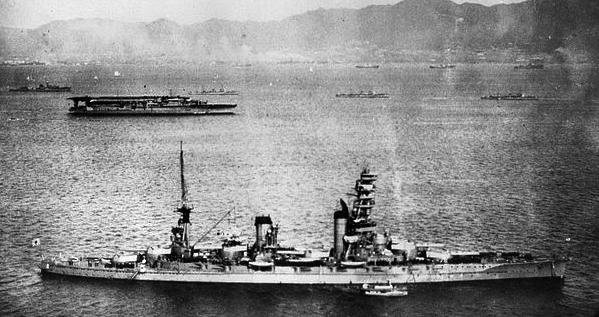
IJN Kaga and Yamashiro in Kobe, 1930
IJN Kaga was officially commissioned on 31 March 1928, and started her sea trials. She joined only the Combined Fleet (Rengō Kantai) on 30 November 1929, and spent two years (until late 1931) training extensively. Her “operational” career really started on 1 December 1931 as she was assigned as flagship of the First Carrier Division (Rear Admiral Takayoshi Katō), teaming with Hōshō and Akagi. She departed for Chinese waters on 29 January 1932 as the Imperial Japanese Army launched a full scale invasion after the Shanghai Incident. The First CarDiv was then assigned to the IJN 3rd Fleet. She deployed her B1M3s during the attack of Shanghai.
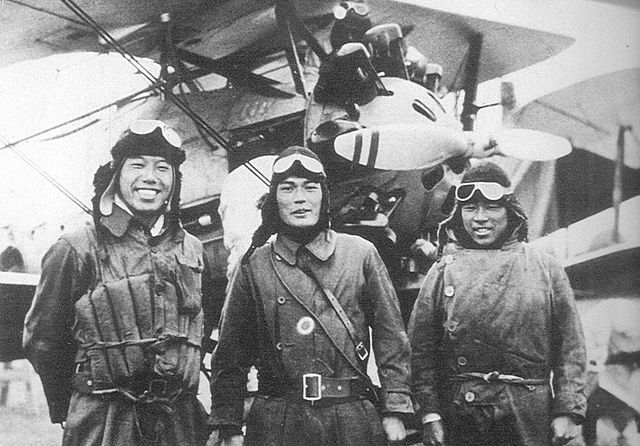
Ikuta, Kuroiwa, and Takeo pose in front of a Nakajima A1N2 Type 3
Kaga’s aviation started to patrol the sky off Shanghai, both from the carrier and Kunda Airfield nearby. This missions soon transformed into close support for Japanese ground forces from February 1932. One day this month, three Kaga’s A1N2 fighters (one piloted by future ace Toshio Kuroiwa) were escorted three Mitsubishi B1M3 torpedo bombers when they encountered a Chinese Boeing P-12 flown by an American volunteer pilot, recording the first IJN first air-to-air combat victory. IJN Kaga and her air group were back in home waters as a cease-fire was declared on 3 March. Intensive training with the Combined Fleet went on for the remainder of 1932.
This time was crucial to help develop IJN carrier doctrine and aerial strikes against enemy carriers were planned for training during the winter of 1932 and allong along 1933. The “First strike” was soon a tactic which required coordination with and without the main battle line. These carrier operations shown that a longer flight deck was required since the new planned generation of metal monoplanes, longer range, could not operate properly for Kaga. Thus, the admiralty planned her reconstruction.
She was given priority over Akagi due to her slower speed, a flight deck 19.5 m shorter and its experimental, impractical funnel arrangement. She was therefore was relegated to reserve status on 20 October 1933 and joined the dockyard, reconstruction officially starting on 25 June 1934, after blueprints were generated and a process to martially removed her decks and modenrized her powerplant as well. This was over in November 1935 and she returned to service, with the Second Carrier Division.
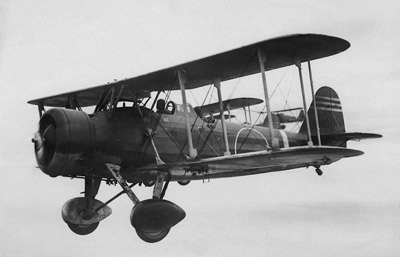
Aichi D1A
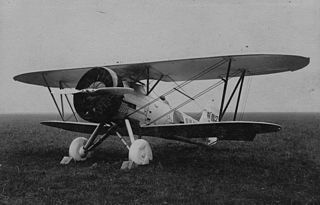
Nakajima A2N-1 fighter bomber
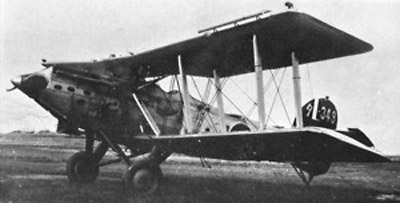
Mitsubishi B2M torpedo bomber
For her new operational assignment, Kaga had a new generation air group comprising 16 Nakajima A2N Type 90 fighters, 16 Aichi D1A Type 94/96 dive bombers, and 28 Mitsubishi B2M Type 89 torpedo bombers. They were all biplanes, the last in fact of the IJN, partially in metal, sturdier, heavier and almost twice powerful as in the 1920s. She spent the years 1936 and 1937 training intensively in home waters. For the detail, Captain Mitsunami was replaced by Captain Inagaki Ayao on the first December 1936. KAGA was attached to CarDiv 2, escorted the destroyer Division 22 and SATSUKI, MINAZUKI, FUMIZUKI and NAGATSUKI.
Sino-Japanese War (1937)
The Marco Polo Bridge incident in July 1937 had Japan declaring war on Japan, officially this time, allowing large scale operations at first targeted against Mandchuria. IJN Kaga by the time was missing her fighter squadron, which completed training at Ōmura (Nagasaki). She recuperated them and escorted a troop convoy to China. On 15 August with Hōshō and Ryūjō she joined her station of the East China Sea, 3rd Fleet. Her air group started to support ground operations along the central China coast and down south to Shanghai. Her planes interveed even further inland, using captired airfields along the way. Their major battle was on 15 August 1937, as thirteen Aichi D1A1 dive-bombers were met by a swarm of Curtiss A-12 Shrike (26th-27th Squadrons) over Chao’er Airbase around Shanghai. The dogfight saw two D1A1s down and a third badly damage, but with the loss of three Shrikes on the Chinese side. On 16 August 1937, six Type 90 fighters fought over Kiangwan, shooting three more without loss. On the period 17 August-7 September, Kaga took part in more engagements, and on the 22 August, received her first new Mitsubishi A5M Type 96 monoplane fighters. He fighter pilots claimed 10 Chinese aircraft with no loss. However on 17 August 12 bombers targeted Hangchow and all but one were shot down by Chinese fighters. On 7 September, three A5M escorted six D1A2, intercepted by three Chinese Hawk IIIs near Taihu Lake. Two bombers were shot down, but the Chinese were repelled. On 15 September six bombers, six fighters, 18 dive bombers, and 18 torpedo bombers were based in Kunda Airfield for extended land operations.
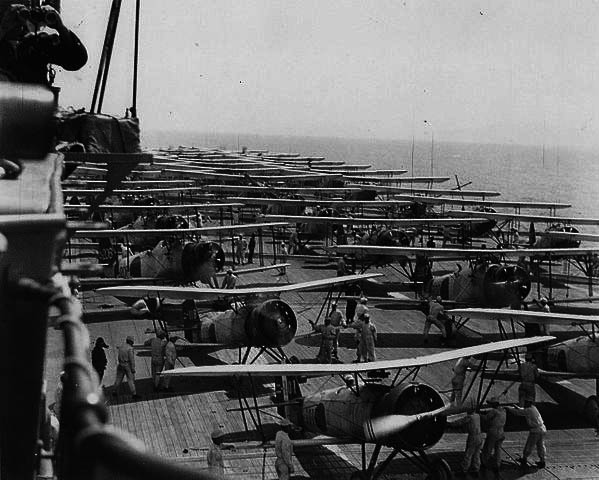
Kaga conducts air operations in 1937; on deck are Nakajima A2N, Aichi D1A, and Mitsubishi B2M aircraft
On 26 September, Kaga was back to Sasebo for supplies and maintenance. She received her replacement air group, comprising 32 Yokosuka B4Y Type 96 torpedo bombers, 16 Aichi D1A and 16 Type 96 fighters, which were already obsolescent but were joined later by four Nakajima A4N Type 95 fighters. She was back off China by early October 1937. Apart two refills/maintenance run to Sasebo, she remained there until December 1938. Taiwan was the advanced operating base, allowing to stay longer and Kaga herself made 29,048 nautical miles during this period, engaing her air group when needed in the South and East China Seas. Her planes attacked troops concentrations, fortifications, railroad bridges, airfields, and vehicles and pilots claimed 17 Chinese aircraft, for five losses during that time. On 11 November three Northrop Gamma 2ECs (2nd BG, 14th Sqn Capt. Yu Y.C.) attacked Kaga, off the Maanshan Islands, close to Shanghai, they missed and were pursued and intercepted by three A5Ms (FL Jirō Chōno) shooting down two. Soon after, six fighters deployed to land bases near Shanghai and Nanking in December.
The Panay Incident (12 December 1937)
That day, Kaga’s air group took part in this incident, also called sometimes the “Kaga incident”. This was a bombing run on the American river gunboat USS Panay, sent as observer and to safeguards US interests in the region, and three Standard Oil Company tankers (Mei Ping, Mei An and Mei Hsia, believed to refuel Chinese aviation), all based on the Yangtze River.
The Gunboat was sunk by bombs from three Yokosuka B4Y Type-96 while survivors were strafed by nine Nakajima A4N Type-95 fighters. The gunboat sank, for a total of 3 killed and 43 wounded. This caused a Public outrage in the U.S., but both sides made conciliations and settled the dispute. Tokyo officially apologized, and paid an indemnity straight away.
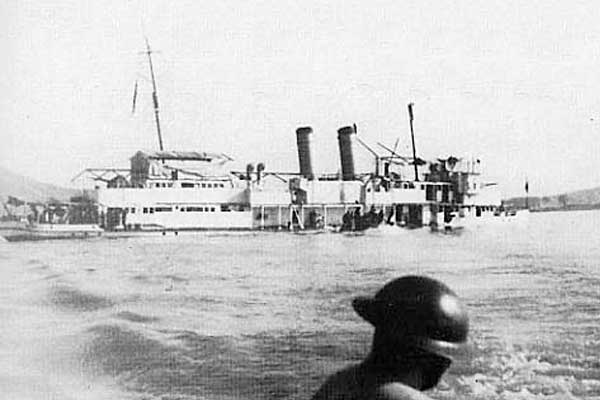
1938 Operations and modernization
Nine fighters were also based closet to Nankin in 3 March-April 1938. On 13 April 1938, Kaga launched eighteen D1A1s protected by A4Ns and A5Ms to strike targets near Canton. They dogfighted with two squadrons of Gloster Gladiators (5th FG, Capt. J. Xinrui Huang, L. Yim-qun) scoring a triple kill. Jirō Chōno (A5M) and Hatsuo Hidaka (A4N) made two each, and this was the occasion for many pilots to gain their first victory as well, all future aces of the IJN. IJN Kaga returned for her maintenance drydock period, on 15 December 1938. Her arresting gear was replaced by the new Type 3 system and her bridge was modernized, as well as the flight deck, hangar areas and overall aircraft capacity. She emerged from the drydock on 15 November 1939, by that time her third reconstruction. On 15 November 1940 after intensive training she was back in active service, with a brand new air group comprising 12 Mitsubishi A5M “Claude” fighters, 24 Aichi D1A dive bombers and 36 Yokosuka B4Y torpedo bombers. Another 18 aircraft were carried in crates as spares.
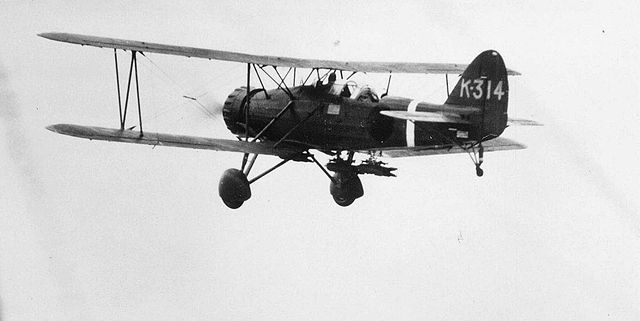
Yokosuka B4Y
1941 Operations:
Her rebuilding is completed on 18 November 1940, and nothing much happened since, on 5 December she departs Sasebo for Kagoshima and for next two months cruise between Kagoshima and Makurazaki.
On 10 April 1941 the First Air Squadron joins the newly organized First Air Fleet and she is assigned to CarDiv 1., training around Kyushu’s coastal waters. In May she is Sasebo NyD for maintenance and is probably fitted with an external degaussing coil and later this month she became the flagship of CarDiv 1. She trained at Beppu Bay, Ariake Bay and Kagoshima, later stops at Yokosuka. On 15 September 1941 Captain Yamada is relieved by Captain Okada Jisaku.
The Japanese carriers experience in China helped finalized the carrier doctrine, notably for concentration and mass projection and culminated in the creation in April 1941 of the “First Air Fleet” (Kido Butai) under a single command. On 10 April, Kaga and Akagi trained together as part of the new carrier fleet with the Second and Fifth carrier divisions. On 20 September she is in Ariake Bay, but departs on 16 October for Kagoshima, back to Ariake, then Hososhima in eastern Kyushu and she lost 23 October her flag to Akagi. On 11 November 1941 she is back to Sasebo Navy Yard Drydock for maintance, and on 18 November 1941 returns to Hososhima, and then Saeki Wan Bay, Kyushu. There she load 100 “special torpedoes” wit wooden tails for the Operation on Hawaii. Those are Type 91 Model 2 torpedoes modified by Mitsubishi for shallow waters and they will prove critical.
Path to war (Nov-Dec. 1941)
On 19 November, Kaga departs Saeki for Hittokapu Wan, Tenzan Bay and then Etorofu-To in the Kuriles island, secret gathering point for the operations. On the 22, she received her last new planed for completing her new air group: 18 Type 0 Mitsubishi A6M2 Reisen “Zeke”, 27 Type 97 Nakajima B5N2 “Kate”, 27 Type 99 Aichi D3A1 “Val”. On the 26, Vice Admiral Nagumo made a serie of conferenceon Akagi for the “Hawaii Operation” and planned refueling operations and gathering on pre-posted points for two Supply Groups: Captain Ota Masanao’s Supply Group No. 1’s oilers KYOKUTO (F), KOKUYO, KENYO and SHINKOKU MARU, and Captain Niimi Kazutaka’s Supply Group No. 2’s oilers TOHO, TOEI and NIPPON MARU.
The Combined Fleet, refueling proves impossible in the stormy waters of the Northern Pacific. Akagi, Soryu, Hiryu and the destroyers are detached and it is planned to use only Kaga, Shokaku and Zuikaku, in no need of refuelling. But on 2 December the fleet is now 940 miles N of Midway while signal “Niitakayama nobore 1208” is given from the Combined Fleet, X-Day planned for the 8 December, Japan time. The Weather conditions worsen the next day, the destroyers are rolling up to 45 degrees and the refueling is cancelled. The fleet follows a course across the north-central Pacific to avoid commercial shipping lanes, but is baterred by heavy weather.
Pearl Harbor
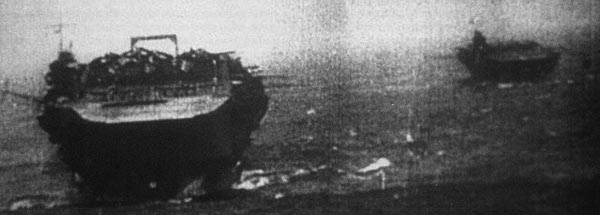
Kaga (foreground), Zuikaku (background) heading towards Pearl Harbor sometime between 26 November and 7 December 1941.
For the attack, Kaga’s air group comprised in addition three crated aircraft of each type, with a dedicated team ready to mount them for quick replacements. On the morning of 7 December 1941, IJN Kaga’s air group is part of the first strike from 230 nautical miles (430 km). 26 B5N came from Kaga in this wave (torpedo bombers) escorted by nine Zeros. The second strike saw Kaga’s 26 dive bombers launched, concentrating on installations on Ford Island, again escorted by nine Zeros. Kaga air group lost five B5Ns, four Zeros and six D3As during the operations, making a net loss of 31 traine dpilots and crewmen. Given the results, this a small price to pay. But Kaga’s planes claimed hits on USS Nevada, Oklahoma, Arizona, California, West Virginia, and Maryland and to have shot down one aircraft, destroyed 20 on the ground. Kaga then departs to home waters. A third wave could have been done, to cripple Pearl Harbor’s fuel reserves, or the fleet deployed to search for the missing carriers the next days, but it is chosen otherwise by a prudent Nagumo. Pearl Harbour had nothing to offer in terms of defence after the second wave, despite the effect of surprise was lost.
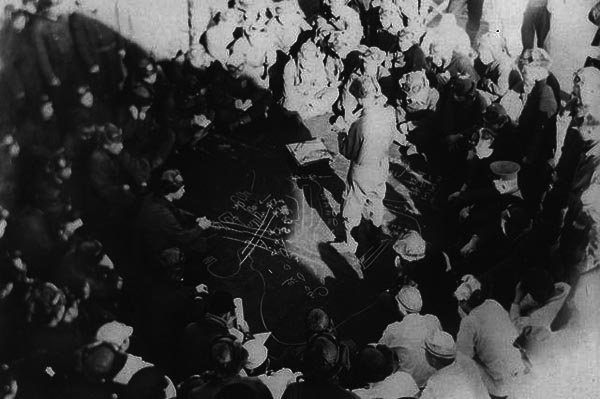
Left: Lieutenant Ichirō Kitajima briefs his B5N crews on the carrier deck about the attack plan the day before the raid on Pearl Harbor.
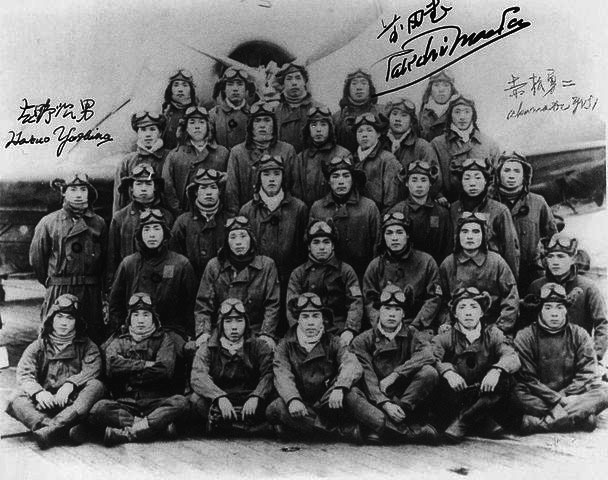
Kaga B5N aircrew at Pearl Harbor
Pacific Operations: Rabaul, Marshall, Java
In January 1942, Kaga’s division is back in operation with Akagi and the Fifth Carrier Division carriers. They are sent to Truk in Micronesia to support the invasion of Rabaul (Bismarck Islands). Kaga launched 27 B5Ns (with bombs) escorted by 9 Zeros over Rabaul on 20 January 1942, one B5N is claimed by AA fire. Allied positions are attacked the next day by sixteen D3As. The day after, however, two dive bombers had to make emergency landings. Kaga is back to Truk on 25 January. Rabaul and Kiaveng fell soon after.
On 9 February 1942, IJN Kaga hit a reef at Palau while en route to intercept the USN carrier force in the Marshall Islands. The damage saw her down to 18 knots but she received temporary repairs and joined the Kido Butai in the Timor Sea on 19 February with the first two division. All four carriers launched their air groups on Darwin, Australia from 100 nautical miles southeast of Timor. Kaga sent 27 B5Ns, 18 D3A, and 9 Zeros which shoot down oppsition and strafed the harbor. Eight ships sunk, fourteen damaged and Kaga lost a single B5N.
In March 1942 IJN Kaga is now based at Staring-baai to cover the invasion of Java, notably on 5 March 1942 during the strike on Tjilatjap. She sent 27 B5N under fighter escort, and they sank (ombined with the rest of the 1st air fleet) eight ships while AA batteries are silence and a large warehouse destroyed. There is no loss. Contrary to her sister ship Akagi however, IJN Kaga is unable to participate in the Indian Ocean raid in April 1942. Damaged, she is sent to Sasebo on 15 March for repairs, starting in drydock on 27 March and over on 4 May. She is also absent for the battle of the Coral sea, but made ready for Operation Mi, Yamamoto’s attack on Midway, hoping to draw out the remaining US carriers in a decisive battle.
Battle of Midway
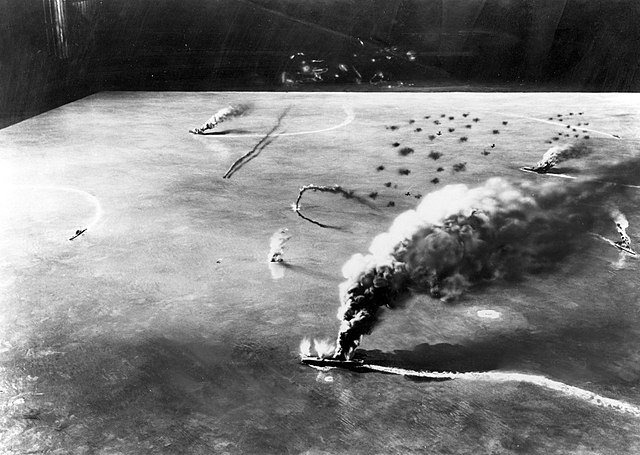
In support of this operation Kaga departs the Japanese Inland Sea on 27 May 1942 with the Combined Fleet (Akagi, Hiryū, Sōryū, 1st ad 2nd Carrier Divisions). By that time, her final air group comprises 27 Zeros, 20 D3As, 27 B5Ns. The fleet ttook position 250 nmi northwest of Midway Island, at dawn, on 4 June 1942. IJN Kaga then launched for the first strike eighteen D3As (Lt. Shōichi Ogawa) escorted by nine Zeros. The B5Ns are armed and made ready to take off with torpedoes meanwhile, in conformity to Yamamoto’s order in case the US carrier force is spotted. Therse is an ongoing air search meanwhile, largely unsuccessful. One D3As and one Zero are shot down by Midway’s AA fire, four D3As damaged. But Zero pilots claimed 12 US aircraft over Midway, mostly Buffalo fighters. Kaga, like Akagi, contributes one single B5N for reconnaissance and placed only two Zeros on CAP (air patrol), soon followed by five more at 07:00. meanwhile the well informed carrier fleet is positioned northeast of Midway.
Midway’s attack are serious and at 07:15, Admiral Nagumo ordered the B5Ns to be rearmed with bombs to attack Midway, contrary to Yamamoto’s orders. This process is very slow and torpedoes remains in the hangar to gain time, while bombs are moved up from their magazine, assembled and mounted in the hangar. The flight deck is left free to received the planes returning from the first wave. This takes an hour and a half, until at 07:40 Nagumo reversed his order as the US fleet is spotted, and in between three Zeros lands to refill.
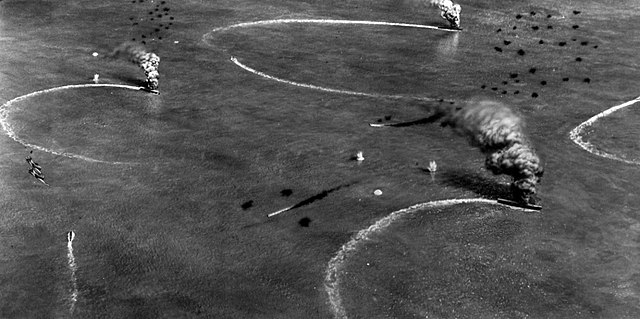
By the time the attack intensified, Kaga only contributes four remaining Zeros in the defensive patrol around the kido Butai, and they were just about to land when 16 SBD Dauntless dive-bombers from Midway attacks Hiryu without result, then B-17 Flying Fortresses. It should be noted than soon after, even the D3A could be used as a fighter, and five are launched to grows the CAP, and then three Zeros at 08:30 while the 1st Midway strike starts to land at 08:35, until 08:50, with a crash-landing. Kaga’s six zeros are back into the air when a carrier-borne assault arrived from Douglas TBD Devastators from VT-8 (Hornet) at 09:22, all shot down with no hit. It is followed by a wave of 14 Devastators from VT-6 (Enterprise), and they split and tried to sandwich IJN Kaga which is manoeuvering, but they are caught by the CAP, which grew of six more Zeros and are all shot down, while torpedoes are duds or are dodged.
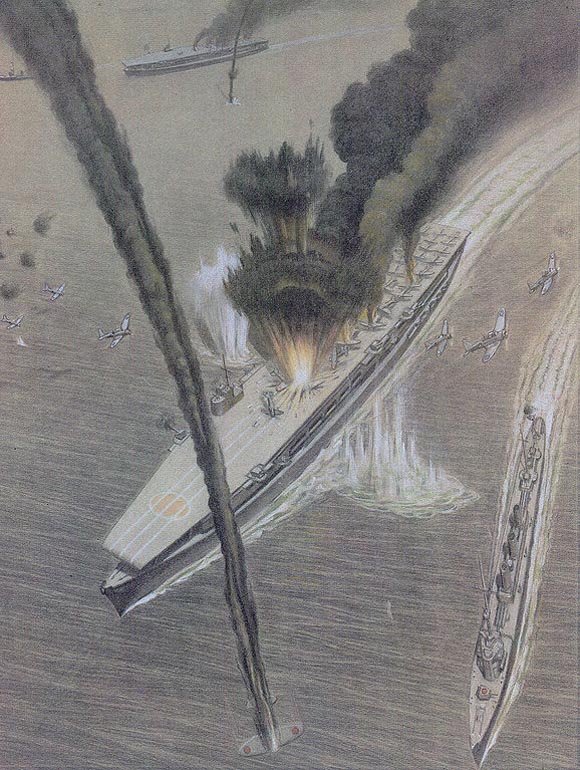
This is the key moment of the battle: American carrier dive bombers arrives almost undetected and attacks at 10:22. One of the 25 SBD Dauntless from USS Enterprise (C. Wade McClusky) hit Kaga with a single 1,000-pound (450 kg) AP bomb, while the carrier took three more 500-pound (230 kg) bombs hits. The first, heaviest bomb hit close to her rear elevator. The berthing compartments are soon on fire. The second hit the forward elevator, and made its way into the upper hangar. Explosions soon rocks the ship and and fire is soon unstoppable, transmitted from one plane to anoher filled with gasoline. The third bomb was a lucky hit: It struck the island and destroyed the bridge instantly. Captain Jisaku Okada and his command staff is eliminated, she ship is now headless. Ongoing explosions also ruptured Kaga’s aviation gasoline lines, and destroyed her port and starboard fire lines. Her emergency generator for fire pumps is knocked out as well as the carbon dioxide fire suppression system. The aviation gasoline spreads further into the ship and eventually finds 80,000 pounds (36,000 kg) of bombs and torpedoes in the hangar deck. The force of the expliosion is enough to blew the hangar sides. Meawnhile Akagi is also devastated.
Kaga’s survivors are later evacuated by the destroyers Hagikaze and Maikaze around 14:00-17:00 and at 19:25 Yamamoto gave the order to scuttle them, which is made by a torpedo spread from Hagikaze. Kaga sank, stern-first, and an injured crewmembed from a B5N, Ensign Takeshi Maeda described: “My comrade carried me up to the deck so I could see the last moments of our beloved carrier, which was nearby. Even though I was in pain tears started to run down my cheeks, and everyone around me was crying; it was a very sad sight.” All in all, Kaga suffered 811 fatalities, chiefly the aircraft mechanics and armorers in the main hangar as well as ship’s engineers trapped below in the boiler and engine rooms. The fire was so fierce there was no way to join the upper level. In addition 21 aviators are killed. The survivors are later restricted in an airbase in Kyūshū, for two months to conceal the defeat from the Japanese public. Many never saw their families and are transferred back to frontline units while the injured are quarantined in hospitals for a year. Kaga had the highest mortality percentage of all carriers.
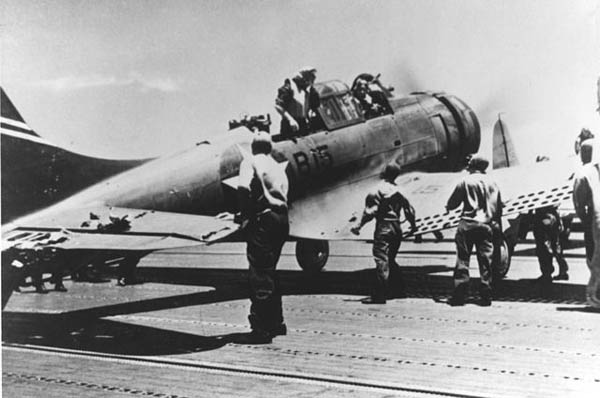
SBD landing after attacking Kaga
In May 1999, Nauticos Corporation worked with US Navy to rediscover the wreck of Kaga, from the research vessel Melville, during a fleet exercise in the area, using the new SEAMAP acoustic imaging system. USNS Sumner made another sweep in September 1999 and took photos of some hangar wreckage under 17,000 feet (5,200 m) of water. Eventually, on 18 October 2019, Rob Kraft and Frank Thompson aboard RV Petrel explored the main wreck, sitting upright under 18,000 ft (5.4 km), buried in the seafloor. Both her superstructure and flight deck were gone, and she was surrounded by a large debris field. Akagi was found later.

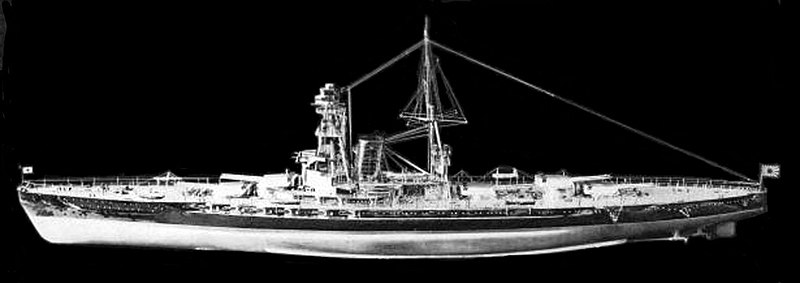

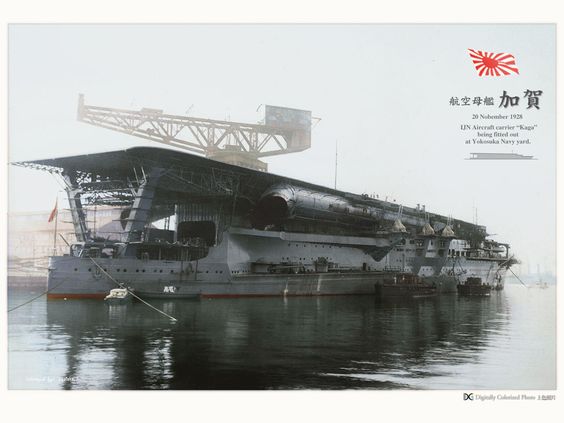






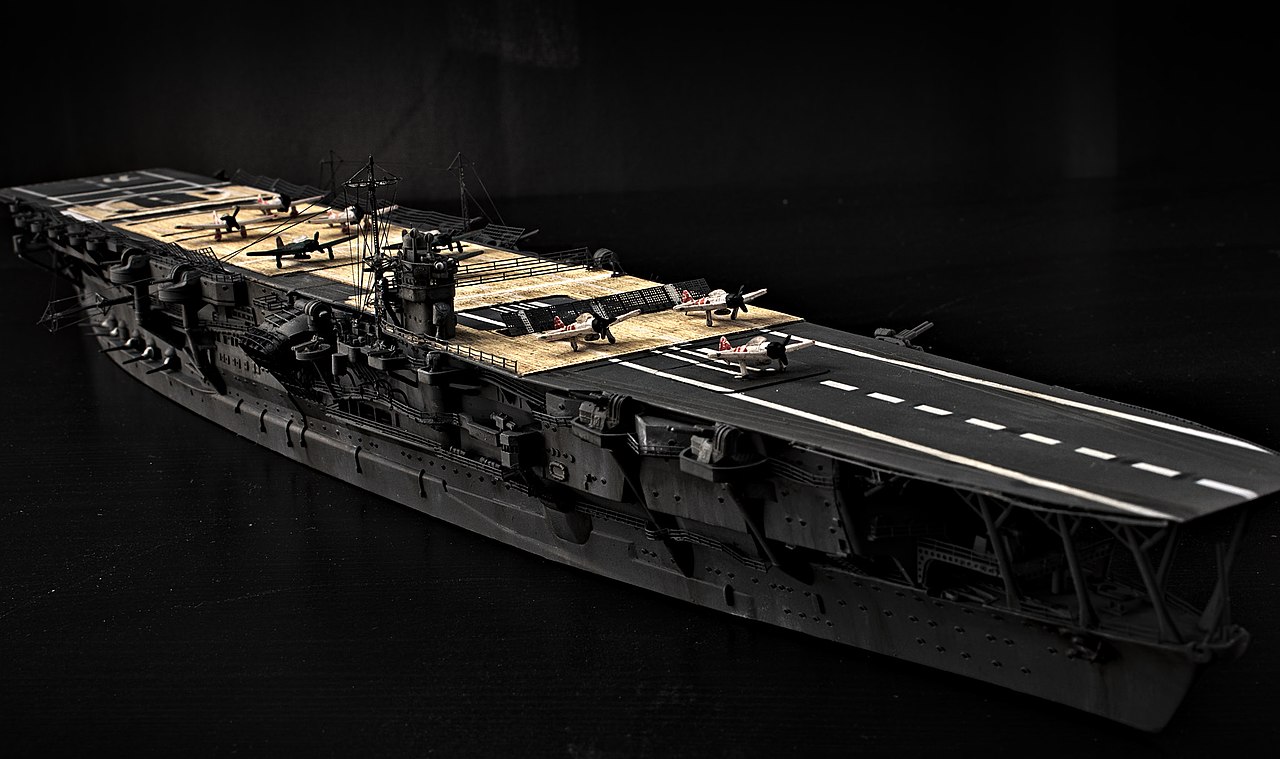
 Latest Facebook Entry -
Latest Facebook Entry -  X(Tweeter) Naval Encyclopedia's deck archive
X(Tweeter) Naval Encyclopedia's deck archive Instagram (@navalencyc)
Instagram (@navalencyc)





 French Navy
French Navy Royal Navy
Royal Navy Russian Navy
Russian Navy Armada Espanola
Armada Espanola Austrian Navy
Austrian Navy K.u.K. Kriegsmarine
K.u.K. Kriegsmarine Dansk Marine
Dansk Marine Nautiko Hellenon
Nautiko Hellenon Koninklije Marine 1870
Koninklije Marine 1870 Marinha do Brasil
Marinha do Brasil Osmanlı Donanması
Osmanlı Donanması Marina Do Peru
Marina Do Peru Marinha do Portugal
Marinha do Portugal Regia Marina 1870
Regia Marina 1870 Nihhon Kaigun 1870
Nihhon Kaigun 1870 Preußische Marine 1870
Preußische Marine 1870 Russkiy Flot 1870
Russkiy Flot 1870 Svenska marinen
Svenska marinen Søværnet
Søværnet Union Navy
Union Navy Confederate Navy
Confederate Navy Armada de Argentina
Armada de Argentina Imperial Chinese Navy
Imperial Chinese Navy Marinha do Portugal
Marinha do Portugal Mexico
Mexico Kaiserliche Marine
Kaiserliche Marine 1898 US Navy
1898 US Navy Sovietskiy Flot
Sovietskiy Flot Royal Canadian Navy
Royal Canadian Navy Royal Australian Navy
Royal Australian Navy RNZN Fleet
RNZN Fleet Chinese Navy 1937
Chinese Navy 1937 Kriegsmarine
Kriegsmarine Chilean Navy
Chilean Navy Danish Navy
Danish Navy Finnish Navy
Finnish Navy Hellenic Navy
Hellenic Navy Polish Navy
Polish Navy Romanian Navy
Romanian Navy Turkish Navy
Turkish Navy Royal Yugoslav Navy
Royal Yugoslav Navy Royal Thai Navy
Royal Thai Navy Minor Navies
Minor Navies Albania
Albania Austria
Austria Belgium
Belgium Columbia
Columbia Costa Rica
Costa Rica Cuba
Cuba Czechoslovakia
Czechoslovakia Dominican Republic
Dominican Republic Haiti
Haiti Hungary
Hungary Honduras
Honduras Estonia
Estonia Iceland
Iceland Eire
Eire Equador
Equador Iran
Iran Iraq
Iraq Latvia
Latvia Liberia
Liberia Lithuania
Lithuania Mandchukuo
Mandchukuo Morocco
Morocco Nicaragua
Nicaragua Persia
Persia San Salvador
San Salvador Sarawak
Sarawak Uruguay
Uruguay Venezuela
Venezuela Zanzibar
Zanzibar Warsaw Pact Navies
Warsaw Pact Navies Bulgaria
Bulgaria Hungary
Hungary

 Bundesmarine
Bundesmarine Dutch Navy
Dutch Navy Hellenic Navy
Hellenic Navy Marina Militare
Marina Militare Yugoslav Navy
Yugoslav Navy Chinese Navy
Chinese Navy Indian Navy
Indian Navy Indonesian Navy
Indonesian Navy JMSDF
JMSDF North Korean Navy
North Korean Navy Pakistani Navy
Pakistani Navy Philippines Navy
Philippines Navy ROKN
ROKN Rep. of Singapore Navy
Rep. of Singapore Navy Taiwanese Navy
Taiwanese Navy IDF Navy
IDF Navy Saudi Navy
Saudi Navy Royal New Zealand Navy
Royal New Zealand Navy Egyptian Navy
Egyptian Navy South African Navy
South African Navy






























 Ukrainian Navy
Ukrainian Navy dbodesign
dbodesign